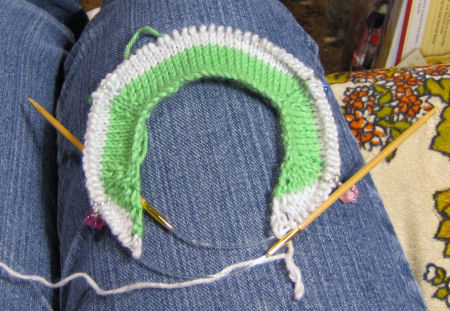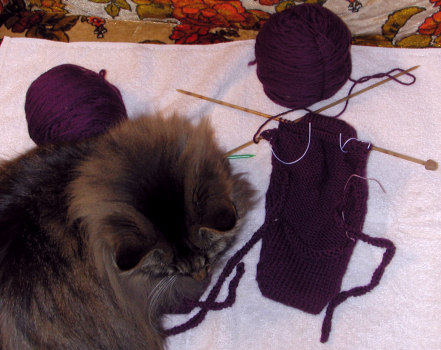Don't fear math in knitting. Math is your friend. And I'm not even going to ask you to do anything hard like algebra or calculus, and I'll only ask you to do it once per project.
I'm going to say something blasphemous, but you have to wait for the but afterwards. Ya ready?
Blasphemy: That gauge on a pattern? That's just a suggestion.
BUT.
You need to know how to take that suggestion.
And yes, you do have to make a gauge swatch in order to take that suggestion. Maybe several. I'm not helping you weasel out of that now. ^_~
I've seen so many people tear their hair out because either they can't quite hit a pattern's gauge, or they decided they were close enough and weren't happy with the results when they actually knit it. This doesn't have to happen, if you just know how to do a tiny bit of mathematical finessing figure out what's going to happen, and how (sometimes if) you can work around that using the pattern as it's written, if it's a multi-size pattern.
Let's take for an example, you want to make
Knitty's "Banff" (which I will probably always try to say 'Bamf', X-men fan that I was.) The gauge on that is 14 stitches per 4 inches. But, the yarn you want to use is TERRIBLE at the gauge when you made your swatch. It's like armor, it'll never work. So, try again until you get a fabric you like, and measure that gauge. Let's say, so I'll get some dramatic numbers here, that it comes to 12 stitches per four inches instead. And you want to make the large one.
Well, if you follow the pattern for the large one, your finished sweater is not going to be the 57 inches it was designed at. It's going to be a whopping 66 1/2".
What butt did I pull that number out of? Actually, it's pretty easy. Take the measurement, 57". Multiply it by the pattern gauge, 14. Yes, I know that's 14 per 4 inches, but you can ignore the "4 inches" for now (and I'll explain why in a minute). So, 57 x 14 = 798. This number doesn't actually equate to anything in real life, but it's an important step. Now, take that number, and divide by your gauge. In this case, that's 798/12, which equals 66.5".
To summarize, to figure out the actual size a garment is going to be, take the pattern's finished measurement, multiply it by the pattern gauge, and divide it by your guage.
(Pattern's finished measurement) * (pattern gauge)/(your gauge).
The reason you didn't have to worry about the "4 inches" is because both your gauge and the original are done over the same distance. They cancel out, so you can ignore them. Now, if the original was 4 inches, and you only measured yours over 3, then when you did the math, the gauges would have been (14/4) and (12/3).
If you're slightly math phobic, do it the easy way. Take both gauges over the same distance.
Anyway, back to the example. You don't want a 67" sweater, you want a 57" one. Is there another size you can knit to get what you want? Well, let's find out. (And, um, let's pretend there's more than one alternative there. ^_^;)
What to do? Just flip the gauges. In other words, take the size you want to make, multiply it by your gauge, and divide by the pattern gauge. So, take 57", multiply by 12, and divide by 14. That comes to 48.9". The Banff sweater doesn't have a 49" size, but it does have a 50" one. Would that be close enough?
Let's find out again! Do the first part again; use your gauge to figure out how big the sweater would actually be if you knit the smaller instructions with your gauge. Take 50", multiply it by 14 (the original gauge), and divide by 12 (your gauge). That's about 58 1/3". Now, take out a tape measure, put it around yourself, and see if you would be happy if your sweater was 58" instead of 57". With something this bulky, I imagine the answer is yes. But if it isn't, at least you don't have to knit the whole sweater to find it out. You've already done so without knitting a stitch.
So, to summarize again. You know what gauge you want to knit at (your gauge, of course).
To figure out what size THEIR pattern will actually be, multiple the supposed finished size by THEIR gauge, and then divide by yours.
To figure out what pattern size YOU should knit to get what you actually want, multiply the desired finished size by YOUR gauge, and then divide by theirs.
OK, let's take another example. Say you want to knit
Knitty's Thermal in the 32" size, which has an itty bitty gauge for a people sweater. But, you're knitting just a skosh smaller. Instead of the 28 stitches per 4 inches it calls for, you're getting 28.5. You're thinking that half stitch won't matter, but everyone on the forum says it will. Will it really?
Let's find out! Take 32", multiply by their 28 stitches, and divide by your 28.5. That ends up with an actual finished size of 31.4". Decide if that's acceptable or not.
For the sake of argument, let's say that if this sweater is
any smaller than 32", you're going to pop right out of the darn thing. So, what size would you need to knit to avoid spronging boobage? Take 32" (your minimum size), multiply by 28.5, and divide by 28. That gets 32.6 inches. Since you already know 32 is going to have you embarrassing yourself, you'll have to go up to 34". Which, if you repeat the math, will be 33.4 on you.
By the way, notice how this half stitch actually isn't making THAT much of a difference? In this case, it's half an inch all around, on a sweater made in a very elastic fabric. If I may say so, 'exact gauge' is kind of a bogyman. A half stitch off is not necessarily going to immediately equate to a sweater that would either be big on Goliath or stretch on a Barbie doll. So when someone tries to tell you "oh noes, your gauge will change if you get stressed or unstressed or if the humidity changes or with the moon phase, and if you don't measure it constantly and it shifts a tiny bit your project will be
ruined, and the world will end!" Please blow them a big raspberry and go back to your knitting. Unless you're seeing wild changes in gauge, your base is probably going to be close enough. And if you are seeing wild changes in gauge, that's probably going to bother you well before the sizing does.
And now you know how to predict just how much that will affect you, and how to figure out what size to switch to get what you want.



